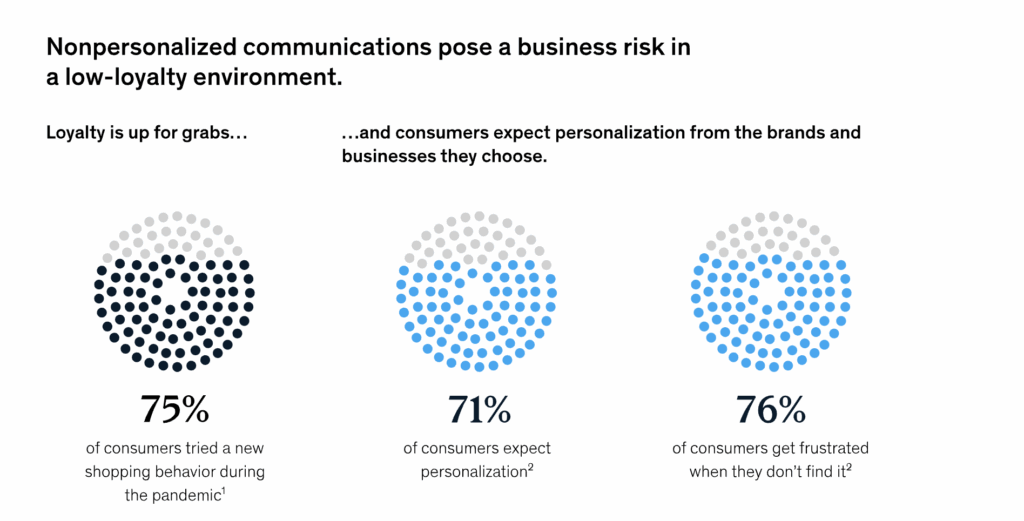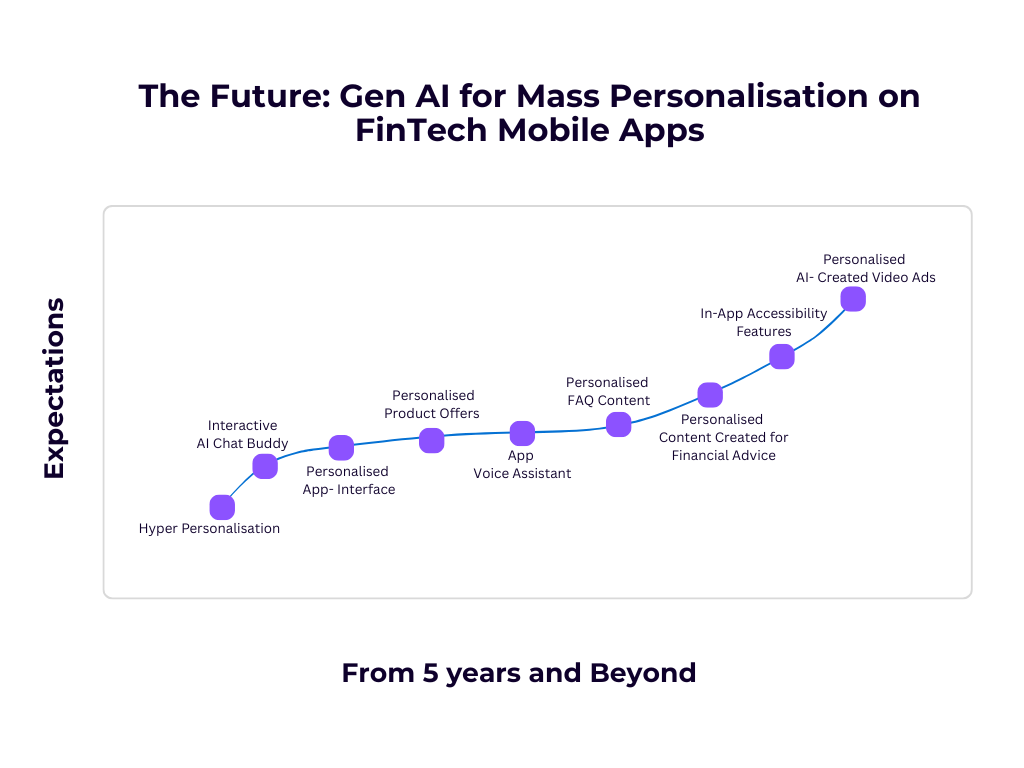Only 3.1% of users who download a finance app are retained by day 30, according to data from Statista1. This is troubling and low. Troubling because finance apps account for 87% of all app install ad spend in Africa2. A 3.1% retention rate is low, compared to business (5.1%), transportation (4.4%), and shopping (4.1%) apps.
If fintechs cannot retain their users, they will have a leaking funnel with little Return on Ad Spend (ROAS).
A McKinsey report reveals that companies that excel at demonstrating customer intimacy generate faster rates of revenue growth than their peers.

IBM says that “fast-growing organisations drive 40% more revenue from personalisation than their more slowly moving counterparts.”
So, one way to fix this broken funnel is to focus on “mass personalisation” that tailors content to each user. However, personalisation at scale is difficult. How will a marketer at FairMoney or Revolut personalise content for their millions of users?
Generative AI can help.
By leveraging data from a user’s engagement history, Generative AI creates personalised content tailored to their preferences.
Ways in which GenAI-personalised content can be deployed
Here are four ways in which GenAI personalised content can be deployed: tailored in-app greetings, dynamically-timed push notifications, richer in-app ads, and personalised discount offers. Breaking them down:
- Tailored in-app greetings: Imagine opening a banking app and instead of a generic “Welcome!”, you see “Good morning, Benjamin! Your investment portfolio saw a 0.5% gain yesterday.” GenAI can analyse your financial activity, recent transactions, and even market trends to create relevant greetings, timely and feel uniquely addressed to you. This goes beyond just using your name; it incorporates contextual financial information to make the greeting more meaningful and actionable.
- Dynamically-timed push notifications to drive action: Instead of sending a push notification at a fixed time, GenAI can learn your financial habits and preferences to send notifications when you are most likely to engage with them. For example, if you typically check your credit card balance at 9 AM, GenAI might send a notification about an upcoming bill payment around that time. It can also consider factors like your location (e.g., notifying you about a nearby ATM with no fees when you’re in the vicinity) or your recent account activity (e.g., reminding you about a pending transaction). The goal is to deliver the notification at the precise moment it’s most likely to lead to a desired financial action, like paying a bill or transferring funds.
- Richer in-app ads: Traditional in-app ads in fintech are often static and generic. GenAI can make these ads more engaging and relevant by dynamically generating content based on your financial interests and profile. For instance, if you’ve been browsing for personal loan options, an ad might feature a newly launched loan product with a competitive interest rate that aligns with your credit score range, along with testimonials from similar customers. GenAI can also personalise the ad’s visuals and copy to better appeal to your individual financial goals, making the ad feel less like an intrusion and more like a helpful financial suggestion.
- Personalised discount offers: Instead of broad discount codes, GenAI can create highly personalised financial offers. This means analysing your spending habits, investment history, and even your stated financial goals to offer discounts or incentives on products or services you are most likely to benefit from. For example, if you frequently use your debit card for online purchases, GenAI might offer you a cashback bonus on your next five online transactions. If you’ve shown interest in a particular investment fund but haven’t allocated funds, it might offer a reduced management fee for a limited time to encourage a first-time investment. The aim is to make the discount or offer feel like a special financial opportunity just for you, increasing its appeal and effectiveness.
In essence, GenAI leverages financial data to understand individual user behaviour and preferences, then generates unique content or experiences that are highly relevant and engaging, making interactions with fintech apps and services feel more personal and valuable.
Tools like ChatGPT, DeepSeek, and Gamma AI on FinTech apps will transform how communications are sent, content is created, and users respond.
Scott Hofmann, GFT’s US CRO, believes fintechs and banks will keep leveraging Generative AI to engage customers, reducing marketers’ workload and boosting revenue. However, there are ethical concerns and considerations around GenAI in content creation that have to be addressed.
Ethical considerations and debates around GenAI in content creation
The Oeconomia Copernicana Economic Journal debates the ethical use of Generative AI in FinTech applications. The study warns that widespread adoption could pose risks to the industry.
While 54% of customers prefer brands to create personalised content, a 2024 Mintel Report reveals that 34% believe Generative AI will negatively impact their lives. FinTech customers share these concerns, particularly regarding emotional marketing based on purchase history, lack of authenticity in recommendations, and accountability issues.
On the creation side, fintech marketers leveraging GenAI could get entangled in the debate around content ownership. If GenAI leverages the existing creative works (e.g. texts and images) of others, and a marketer uses a prompt to generate a campaign poster, does the IP of that image belong to the fintech or the source of the training data used by the AI model? “Needless to say, these technologies will provide substantial work for intellectual property attorneys in the coming years,” a Harvard Business Review article concludes.
The other consideration before mass adoption at Fintechs is to ask, what constitutes a compliant use of GenAI?
What constitutes the regulated and compliant use of GenAI in fintech marketing
On Meta’s group of apps (Instagram, Facebook, WhatsApp), users can leverage AI to create and interact with content. Platforms like X and Snapchat have also adopted AI to enhance customer experiences. While this innovation reduces FinTech marketers’ workload, it comes with regulatory constraints.
FinTech brands, regulated by the UK’s Financial Conduct Authority (FCA), must comply with all laws when personalising content for users.
Here are some legal considerations for fintechs looking to leverage GenAI to create content:
- Data privacy and protection (GDPR laws): With fines of up to 20 million Euros, Fintechs must obtain consent from customers before using their data for personalisation.
- Customer identity verifications (AML/KYC policies): Fintechs must carry out proper KYC Verifications on customers to ensure they are not personalising content to fraudsters.
- Consumer protection (CFPB Guidelines): This law helps Fintechs to be authentic with their service offerings and take responsibility for issues relating to personalised communication.
The future of personalised content creation for fintech apps
As the use of Generative AI in content creation evolves, we will continue to see more use cases of it in fintech mobile apps.
Gartner’s Plateau of Productivity explains the mainstream adoption of technologies. This could be the future use cases of Gen AI content creation on FinTech Mobile Apps. For instance, in addition to all the other use cases discussed above, the industry could see GenAI used for personalised: Video ads, financial advice (within regulatory guidelines), FAQ content, homescreen layout, and customer support.

In conclusion, I recommend that fintech companies explore the use of Generative AI for content creation as it helps with improving the quality, variety and personalisation of content. Such explorations should be guided by the ethical and legal considerations outlined above to prevent expending more energy on resolving legal disputes versus creating world-class GenAI experiences. By leveraging GenAI, fintech marketers can reduce churn and grow revenue for their companies.
- Only 3.1% of users are retained by Day-30. Statista ↩︎
- Finance apps account for 87% of all app install ad spend. Google and AppsFlyer cited by TechLabari ↩︎
Beverly Ezebuike is a globally recognised fintech and blockchain marketing expert, celebrated for her remarkable achievements in driving growth within the tech industry. Throughout her career, she has collaborated with prominent brands such as Binance, Kuda Bank, and Raenest, consistently driving business growth and revenue growth through innovative marketing strategies.
Beverly holds a Master’s degree in Digital Marketing from the University of Northampton, UK, and is a certified Digital Marketing Professional with accreditation from The Digital Marketing Institute. Her outstanding work has attracted over half a million new community members and generated more than $50 million in revenue for brands, establishing her as a standout leader in both African and global tech spaces.
You can visit her website.
This article is part of Condia’s Publishing Partner plan, please contact us hello [at] thecondia.com to learn more.
Get passive updates on African tech & startups
View and choose the stories to interact with on our WhatsApp Channel
Explore





